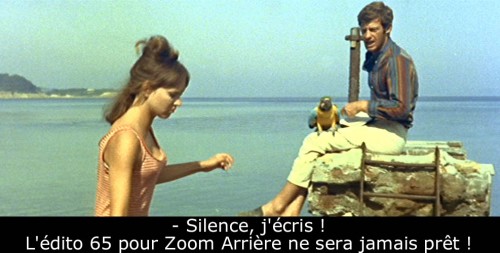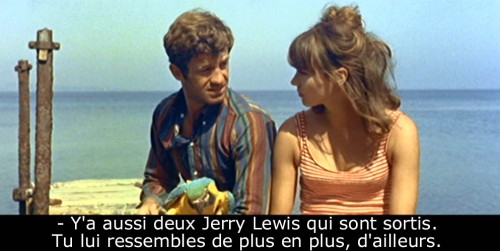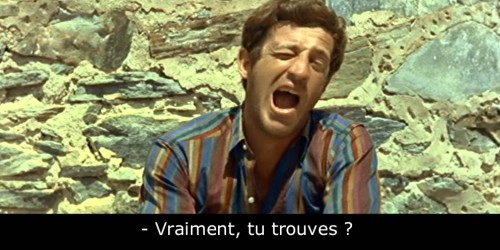The following is Robin Wood's original CineAction! review of Steven Bach's book Final Cut (which has been re-published since then) on the making of Heaven's Gate, which makes a good comparison piece to Pauline Kael's New Yorker review of it (which could be found online here) that was re-printed in her book Hooked. But these aren't the only two positions on Heaven's Gate since the French film critics also wrote a lot about it for its limited release in France. One can even hear a lively argument about Heaven's Gate between Kael and Jean-Luc Godard (here) from around this period.
The French reviews stand a part from the English ones for several reasons. As Bach hints in Final Cut, the American industry magazines such as Variety, that are more interested in the film's commercial potential than its artistic merits, strongly influence the film discourse in the media. It's so powerful up to the point that it infiltrates the prominent film journalism in the country so like the New York Times. Even de Palma acknowledges this when he discusses the necessity of commercial success over artistic merits for a director to continue his filmmaking career. It is then in opposition to this commercial discourse and its negative effects on promotion and emphasis on box office results, along with a stronger conviction in film as an art-form and with a longer intellectual heritage of art and film criticism, that should be the context to view the subsequent reception of Cimino in France. Of particular note-worthy importance are the reviews in Cahiers and those by Iannis Katsahnias, in Positif and those by Laurent Vachaud, and Jean-Baptiste Thoret and his new book Michael Cimino: Les voix perdues de l'Amérique.
Wood, who was in the minority to champion Heaven's Gate in North America (the film only had a brief one-week run in Toronto), offers a similar argument for Cimino as the aforementioned French film critics. For more by Wood on Cimino see his lengthy analysis in the chapter on Cimino in Hollywood from Vietnam to Reagan...and Beyond. - D.D.
***
Final Cut:
Dreams and Disaster in the Making of Heaven’s Gate
By Steven Bach,
Morrow, 1985
First, let it be
said that, whatever your attitude to Heaven’s
Gate, and whether or not you have seen it, Steven Bach’s book is essential
reading for anyone interested in contemporary Hollywood cinema and its
conditions of production. From this viewpoint, it offers a fascinating extended
gloss on points made forcefully and succinctly by Arthur Penn in the interview
in CineAction! N.5: a unifying thread
of the book is the takeover of Hollywood by conglomerates and businessmen who
see movies solely as commodities and assess each project strictly in terms of
its market value – which can be assessed only by reference to the project’s degree
of resemblance to previously lucrative commodities. Bach looks back
nostalgically to the time when United Artists was formed by a group of united
artists – Griffith, Chaplin, Fairbanks, Pickford. What is most touching about
the book is its sense of someone trying to preserve a tradition of ‘quality’
and, above all, decency in an age that has rendered such ambitious obsolete.
Bach’s supreme consciously held value would appear to be fairness: the book
attempts to be fair to everyone, even to Cimino, meticulously documenting and
verifying everything that can be documented and verified, trying to understand
points of view. While no one is exempted from criticism, Bach builds portraits
(the ‘rounded characterizations’ of the popular novelist) of many of his colleagues
that convey generosity, affection and respect.
The attempt at
fairness is, in Cimino’s case, only partially successful. It is not only that
Bach’s animus against Cimino continually threatens to, and occasionally does,
erupt: the problem is fundamental. Like Count Dracula in Bram Stoker’s novel,
Cimino cannot be permitted to express a point of view or the entire moral
structure of the book would collapse. Also like Dracula, he is absent from its
surface for most of its length, a terrible, unpredictable, ultimately
incomprehensible hidden force. Unless Bach is lying (and nothing suggests to me
that he is), it is clear that Cimino (again like Dracula) behaved very badly in
a number of ways during the making of the film, and there can be no doubt that he
exasperated and antagonized a lot of not unreasonable people. Yet the sense
that the book cannot really understand him remains inescapable, and one
suspects, beyond that, that it cannot afford
to understand him: it’s own point of view would be too seriously threatened.
Because he
appears to be utterly unaware of them, Bach exposes his own deficiencies and
limitations with perfect candor. The image he presents of himself and the
precise nature of his commitment to the cinema is two-fold: he is, as any successful
Hollywood executive of course must be, a shrewd and intelligent businessman; he
is also interested in film as ‘art.’ He is clearly dedicated to reconciling
these concerns – or, to put it another way, to suppressing any sense that there
might be a serious conflict between them. The businessman side can be
unproblematically proud that United Artists produced the James Bond movies; the
problem arises with Bach’s notion of what constitutes a ‘great’ film. To be
‘great,’ it seems, a film must be both
‘artistic’ (i.e. displaying a certain set of signifiers that the bourgeois
audience can identify as such) and commercially successful; Bach’s notions of
the artistic never transcend the most conventional canons of bourgeois ‘taste.’
The directors he most admires (with perfect logic) – they are held up as
exemplary model figures, in implicit contrasts to Cimino – are David Lead and
Woody Allen: they not only make art and money simultaneously, they also behave
well, they are ‘gentlemen.’ Allen can, I suppose, be defended as a distinctive
minor talent; Lean never transcends an earnest, ponderous and assiduously
‘tasteful’ academicism. Personally, if I had to choose between Heaven’s Gate and their combined oeuvres I would choose Heaven’s Gate.
One of Bach’s
strongest and most often reiterated complaints about Cimino is that he refused
to communicate with anyone (including, of course, Bach himself); it is
possible, however, that he felt that there was no one with whom he could seriously communicate. One wonders
whether he was pleased by Bach’s initial enthusiastic response on viewing the
first set of ‘dailies’: ‘It looks like David Lean decided to make a western.’
That it was impossible for Bach and his associates to get through to him (at
least until the stage of deterioration where communication could only take the
form of threats and counter-threats) does not necessarily prove that he
couldn’t have been reached. Indeed, Bach’s very virtues – reasonableness,
common sense, business acumen – combined with their corollary, a very limited
aesthetic imagination, may well have hindered the communication they were
devoted to trying to serve. It is not a question, of course, simply
irresponsibly indulging Cimino’s excesses, but of understanding the drives that
gave rise to them. There is no doubt that Cimino became increasingly isolated
and that his own actions and attitudes consistently intensified the isolation;
one would like to learn – and Bach can offer few hints – why Cimino felt driven
to behave as he did. Perhaps one day we shall be given his own account of the
making of Heaven’s Gate.
‘Megalomania’
seems too simple – and too simply hostile – an explanation. The line that
separates megalomania from artistic obsession can be narrow to the point of
invisibility. Bach himself testifies (giving them perhaps less emphasis than
they deserve) to a number of positive factions that complicate the popular
image of Cimino-as-monster. The actual work of filming was thoroughly
professional, controlled, discipline; Cimino secured the unreserved dedication
of his actors (I think this is sufficiently evident from their performances on
screen, but it is good to have the impression corroborated); he gave himself to
the project totally and tirelessly, often working 18 hours a day. Bach writes,
generously: “One thing is certain: I believe there to have been not on day or
one moment in the turbulent history of Heaven’s
Gate in which Michael Cimino intended anything other than to create ‘a
masterpiece’, a work of lasting art. His certainty that he was doing so
conditioned that history and much of the behavior of those around him. He did
not set out to destroy or damage a company but believed he would enrich it,
economically and aesthetically.”
In the
contemporary arts in general, but in the modern American cinema especially, the
Cimino of Heaven’s Gate is an
archaic figure, the archetype of the Romantic artist, the person with a vision
so intense and compelling that its realization overrides all considerations of
reasonableness and economics; a vision that became increasingly vast as
shooting progressed, accounting for the fact that the two versions of the film
still have something of an unfinished quality, the air of a ‘work in progress’
that is one of the film’s most fascinating (though not exactly ‘commercial’)
characteristics. There are many reasons, both aesthetic and political, why Heaven’s Gate could not have been a
commercial success in the context of Reaganite America and the cinema it
deserves. Whether it need have been so complete a financial disaster is another
matter. (One also wants to ask why that disaster has been publicized and
flaunted to the point where it has become almost proverbial, while the closely
comparable disaster of John Huston’s Annie
was allowed to slip by almost uncommented.) Had there been people in charge who
were capable f sharing Cimino’s vision and committing themselves to it, the
initial (anti-)critical response might have been braved and something salvaged: certainly not forty
million dollars, but presumably a few million would have been better than
nothing. No box office failure has ever been transformed into a success by
being cut. Personally, I have always felt that the so-called ‘complete’ Heaven’s Gate was not too long but too
short. One of Bach’s most tantalizing revelations is that he and a few other
privileged (and ungrateful people saw Cimino’s original cut – all five hours
and 25 minutes of it. One would like to know what happened to all the footage,
and whether there is any hope that the film might one day be restored, as has
happened with A Star is Born and New York, New York. I am aware that in
the present critical climate the suggestion will provoke raised eyebrows if not
derisive laughter, but let us wait a few years and then see. What is particularly
sad is that, after the disastrous premiere, Cimino’s own confidence collapsed
and he himself (according to Bach) proposed that the film be withdrawn and cut
further: he too was defeated by the response of the fashionable ‘Invitation
Only’ audience and a handful of powerfully influential journalist-reviewers. I
think time will prove that Cimino did indeed
create ‘a work of lasting art.’ There are signs already that rehabilitation is
unobtrusively preparing itself, ad not only in Europe. The reviews of my recent
book Hollywood from Vietnam to Reagan
have been predominantly hostile, but not one so far has challenged by detailed
championship of Heaven’s Gate and
one – the most unfavorable of all – singled it out as one of the book’s only
redeeming features. There is also the phenomenon of the great popularity of Final Cut itself, which has already
gone into paperback: Bach’s book is being read by thousands of people who
presumably have not had a chance to see the film and, while it is true that
everyone loves a good scandal, this seems also to testify to a very widespread
curiosity. It is to Bach’s credit that his book will whet that curiosity rather
than negate it.























